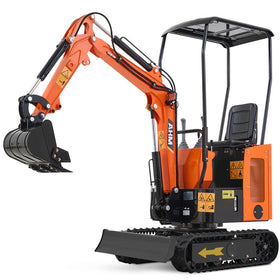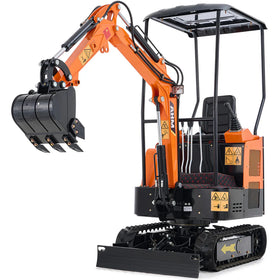When you're looking at mini excavators, the choice often comes down to two popular engines: Kubota and Briggs & Stratton. This choice matters because it affects how well your machine works, what it costs to run, and how long it lasts. Let's look at what makes each engine different so you can pick the right one for your work.
1. Understanding Your Engine Options

The fundamental differences between Kubota and Briggs & Stratton engines stem from their distinct design approaches to power delivery and operational efficiency. Each design serves specific operational needs in mini excavators, affecting everything from daily performance to maintenance requirements.
The Kubota Engine Mini Excavator Edge
A Kubota mini excavator brings serious muscle to construction sites. The D722-E3B delivers 14.9 kW (20.0 HP), making it a heavy duty choice for demanding jobs. Here's what makes it stand out:
- Excellent performance in tight spaces
- Low noise and vibration levels
- Reliable hydraulic hose system support
- Built to minimize downtime on busy sites
The Briggs and Stratton Mini Excavator Advantage
With power options up to 13.5 HP, a Briggs and Stratton engine mini excavator offers versatility for different jobs. It's particularly good for:
- Construction in narrow lanes and alleys
- Work in backyards and gardens
- Projects needing a light yet powerful mini excavator
- Sites where easy maintenance matters
Key Specifications at a Glance
|
Feature |
Kubota D722-E3B |
B&S XR Series |
|
Power Output |
20 HP continuous |
Up to 13.5 HP range |
|
Fuel Type |
Diesel |
Gasoline |
|
Cooling System |
Liquid-cooled |
Air-cooled |
|
Cylinder Configuration |
3-cylinder |
Single-cylinder |
|
Emissions Compliance |
EPA Tier 4 |
Standard gasoline regulations |
2. Performance in Real Working Conditions

In real-world applications, the differences between these engines become particularly evident. The Kubota D722-E3B's liquid-cooled system provides exceptional temperature stability, even in challenging environments. This translates into consistent performance during extended operation periods, making it ideal for applications where downtime isn't an option.
The Briggs & Stratton XR Series, available in power outputs ranging from 3.5 to 13.5 HP, offers remarkable versatility. Its air-cooled design, while requiring more frequent maintenance intervals, provides excellent accessibility for routine service tasks. This accessibility becomes particularly valuable in operations where quick maintenance turnaround is essential.
|
Operating Condition |
Kubota Engine Mini Excavator |
Briggs & Stratton Mini Excavator |
|
Extended Operation |
Maintains consistent power output |
Best for intermittent use patterns |
|
Temperature Management |
Superior stability in harsh conditions |
Efficient in moderate conditions |
|
Power Delivery |
Steady torque for demanding tasks |
Responsive power for varied tasks |
|
Fuel Efficiency |
Optimized for continuous operation |
Efficient for shorter work cycles |
3. Understanding Total Cost of Ownership
The financial implications of engine choice extend far beyond the initial purchase price. A comprehensive view of ownership costs reveals interesting patterns:
|
Cost Factor |
Kubota D722-E3B |
B&S XR Series |
|
Initial Investment |
Higher |
Lower |
|
Fuel Efficiency |
Superior in continuous operation |
Good for intermittent use |
|
Maintenance Intervals |
Longer between services |
More frequent but simpler |
|
Parts Availability |
Specialized dealer network |
Widely available |
|
Service Complexity |
Requires skilled technicians |
More straightforward repairs |
4. Environmental Considerations and Future Adaptability

Today's job sites often have strict rules about engine emissions, and these rules keep getting tougher. The Kubota D722-E3B already meets the EPA's strictest standards (Tier 4), which means you can use it on any job site. This matters especially for government contracts or projects with specific environmental requirements.
Briggs & Stratton keeps up differently. They've made their gas engines cleaner and more efficient with better fuel burning and filtering systems. While they follow different rules than diesel engines, they still run clean enough for most work sites.
5. Making an Informed Decision
To pick the right engine, start by looking at your everyday work needs. Ask yourself:
- What kind of jobs will you handle most often?
- Who will maintain your machine?
- What fuel is easier for you to get and use?
The Kubota D722-E3B really shines when you need non-stop power and reliable performance. It's built tough for serious industrial work, like major construction projects. Just keep in mind you'll need trained mechanics for servicing - it's not a do-it-yourself kind of engine.
The Briggs & Stratton XR Series takes a different approach. It's easier to work on, and most mechanics already know these engines well. Plus, you can find parts almost anywhere. This makes it perfect if you want something that's simple to maintain and can handle different types of jobs throughout the day.
Conclusion: Aligning Engine Choice with Operational Needs
These two engines shine in different types of work. If you're doing heavy-duty jobs like deep excavation or working long hours, Kubota's D722-E3B is your best bet. Professional contractors pick it because it keeps going strong even in tough conditions.
On the other hand, if you need a machine that's easy to maintain and can handle different kinds of jobs, look at the Briggs & Stratton XR Series. It's great for landscaping projects and lighter work where you need to switch between tasks throughout the day.
Your choice between a Kubota engine mini excavator and a Briggs and Stratton mini excavator ultimately depends on three critical factors:
- The nature and duration of your typical projects
- Your existing maintenance infrastructure and expertise
- The total cost of ownership, including fuel, maintenance, and operational efficiency
When these factors align with your operational requirements, you'll find either engine can deliver exceptional value. The key lies not in choosing the most powerful or least expensive option, but in selecting the engine that best matches your specific operational profile and long-term business goals.








1 comment
Thank you David